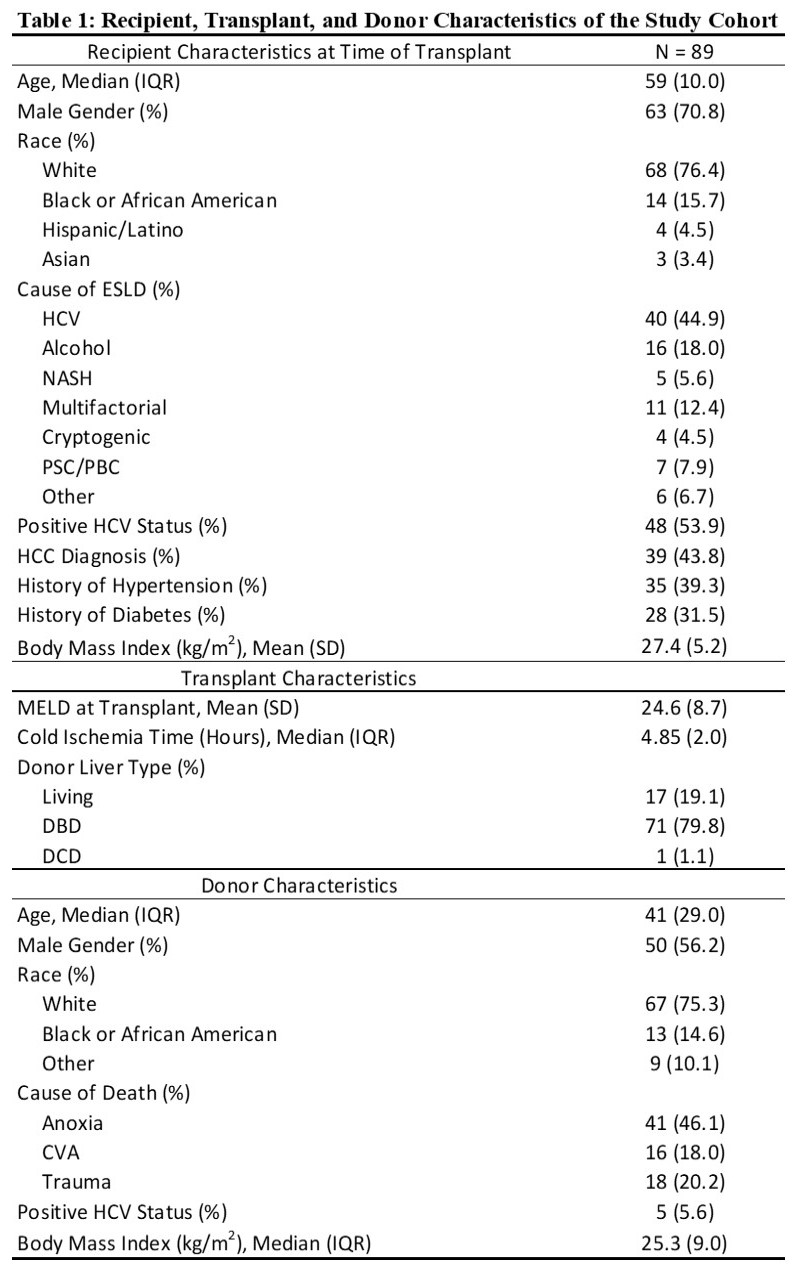The Use of Native Kidney Biopsy to Predict Renal Dysfunction Following Liver Transplantation
1Surgery, Hospital of the University of Pennsylvania, Philadelphia, PA, 2Pathology, Hospital of the University of Pennsylvania, Philadelphia, PA, 3Medicine, Hospital of the University of Pennsylvania, Philadelphia, PA
Meeting: 2019 American Transplant Congress
Abstract number: 555
Keywords: Kidney, Liver transplantation, Outcome, Renal failure
Session Information
Session Name: Concurrent Session: Liver - Kidney Issues in Liver Transplantation
Session Type: Concurrent Session
Date: Tuesday, June 4, 2019
Session Time: 4:30pm-6:00pm
 Presentation Time: 5:30pm-5:42pm
Presentation Time: 5:30pm-5:42pm
Location: Room 302
*Purpose: Acute and chronic kidney injury are a common occurrence for patients with end-stage liver disease and are associated with significant morbidity and mortality. We aimed to determine the utility of native kidney biopsy to predict renal dysfunction following liver transplantation as well as to better characterize pathologic findings in patients with hepatorenal syndrome.
*Methods: We performed a prospective observational trial to identify potential predictors of severe renal dysfunction following liver transplantation. A native kidney biopsy was performed at the time of liver transplantation which was reviewed by a single pathologist. The primary outcome of interest was the development of chronic kidney disease (CKD) stage 4 or 5. The secondary outcome measured was death. Immunofluorescence, light microscopy, and electron microscopy findings on the native kidney biopsy were compared between patients with the primary and secondary outcomes.
*Results: A total of 89 patients underwent native kidney biopsy at the time of liver transplantation. Recipient, transplant, and donor characteristics among the study population are shown in Table 1. 16 patients went on to develop CKD stage 4 or 5 and 14 patients died during the follow-up period. A larger proportion of patients who either developed CKD stage 4 or 5 or died had >20% interstitial fibrosis and tubular atrophy (IFTA) as compared to those that did not experience either endpoint (p-value = 0.03). There were no significant differences in glomerulosclerosis (GS) or arterial sclerosis between the two groups (p-value = 0.18 and 0.38 respectively).
*Conclusions: Cirrhosis of the liver can be accompanied by a variety of microscopic glomerular disorders. Advanced interstitial fibrosis on native kidney biopsy is associated with poor renal outcomes following liver transplantation.
To cite this abstract in AMA style:
Walls DO, Muraveika L, Palmer MB, Sawinski DL, Keating BJ, Abt PL. The Use of Native Kidney Biopsy to Predict Renal Dysfunction Following Liver Transplantation [abstract]. Am J Transplant. 2019; 19 (suppl 3). https://atcmeetingabstracts.com/abstract/the-use-of-native-kidney-biopsy-to-predict-renal-dysfunction-following-liver-transplantation/. Accessed December 15, 2025.« Back to 2019 American Transplant Congress


